The Kgalagadi desert’s butterflies featured in this post resonate with two posts from last year reflecting on resilience and fragility (symbolised by desert flowers) and the need for hope (symbolised by butterflies). It is just over a year since South Africa recorded its first confirmed case of Covid-19 and those posts were in response to the burgeoning uncertainty and fear as the pandemic’s inexorable infection rates escalated across the world.
Globally, locally and individually over the past year or so we have been through times that revealed our resilience and our fragility, and despite – or perhaps because of – all we have been through, we continue to lean towards hope where we can find it.
Desert butterflies exemplify a complex relationship between strength and vulnerability and the ability to survive in challenging circumstances.
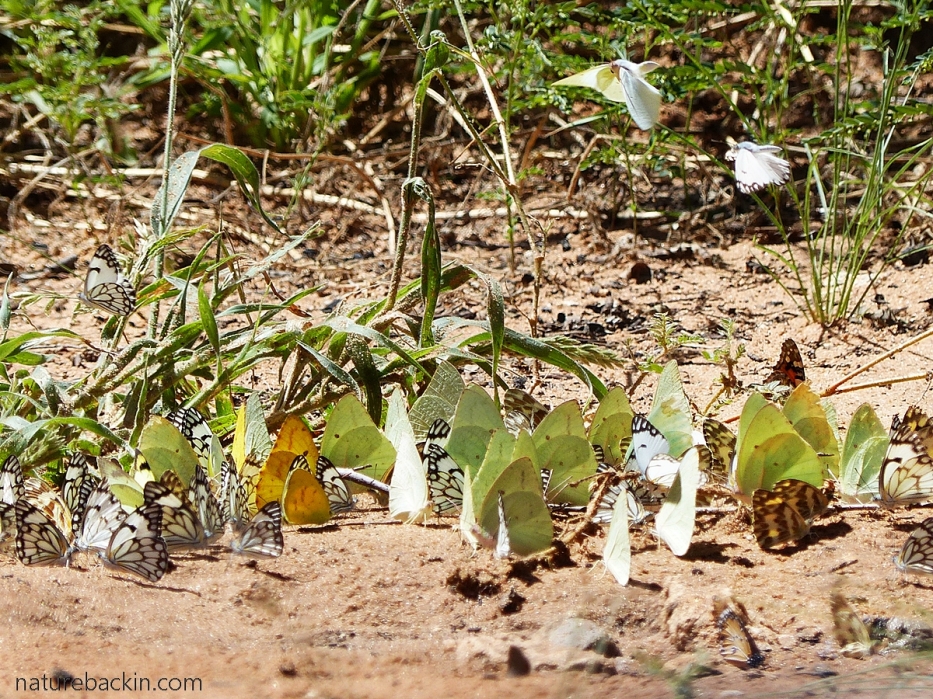
Who would think that in the aridity of the Kalahari there could be such a proliferation of butterflies?
Strictly speaking the so-called Kgalagadi Desert is not truly a desert and is more accurately classed as semi-desert. Even though arid with no surface water, the rainfall and the density of the ground cover exceed the normal criteria for a desert (1992a Larsen: 182). Generally the vegetation cover is too extensive for new dunes to form.
Typical of such arid regions, temperature variations – both daily and seasonal – can be extreme in the Kgalagadi region, which straddles part of the borders between South Africa and Botswana and the eastern part of Namibia. In winter there can be severe frosts with temperatures as low as -15°C (5°F) and it is not unusual for summer daytime temperatures to be well over 40°C (104°F). Of the 250 species of butterflies that occur in Botswana only 41 are found in the Kgalagadi region. Most butterfly species cannot cope with the low or erratic rainfall, and many of those that can cope with drought cannot survive frost.
Most of these photos were taken on visits to Mabuasehube on the Botswanan side of the Kgalagadi Transfrontier Park where the vegetation is largely arid tree and shrub savannah. There are several large salt pans surrounded or covered by open grassland. Some photos were taken at the Central Kalahari Game Reserve (CKGR), Botswana, which has similar vegetation with the addition of fossil river beds and the occurrence of ‘tree islands’. (Kalahari is an alternative spelling of Kgalagadi, which literally means ‘thirstland’.)
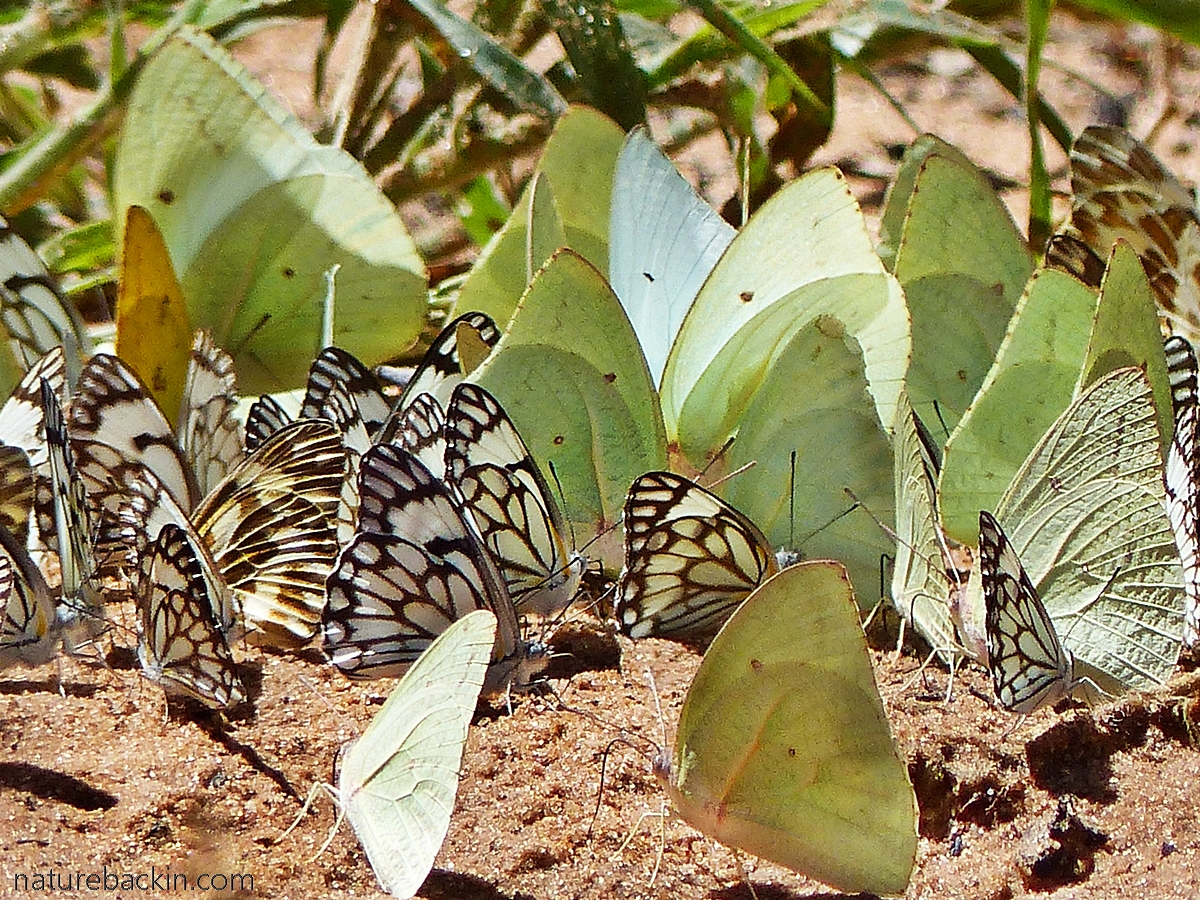
Here Pioneer Caper Whites that are also commonly referred to as Brown-veined Whites (Belenois aurota) and African Migrant (Catopsilia florella) butterflies practically jostle at a mud-puddle
In the Kgalagadi butterflies are known to congregate at mud puddles not only to drink in hot weather but also to suck up minerals and salts available to them in the moist patches. These moist patches can be caused by splashing along the edge of waterholes, by puddles formed by urine (courtesy of animals and even visiting tourists) or, as in the photo above, by water discarded after rinsing off our breakfast mugs and dishes.

Although the Pioneer Caper Whites/Brown-veined Whites and the African Migrant butterflies predominate at many of the mud puddles we also saw Broad-bordered Grass Yellow (Eurema brigitta brigitta) and Common Orange Tip (Colotis evenina evenina) butterflies – these at the Central Kalahari Game Reserve (CKGR). On the right is a tiny butterfly in flight – one of the ‘Blues’
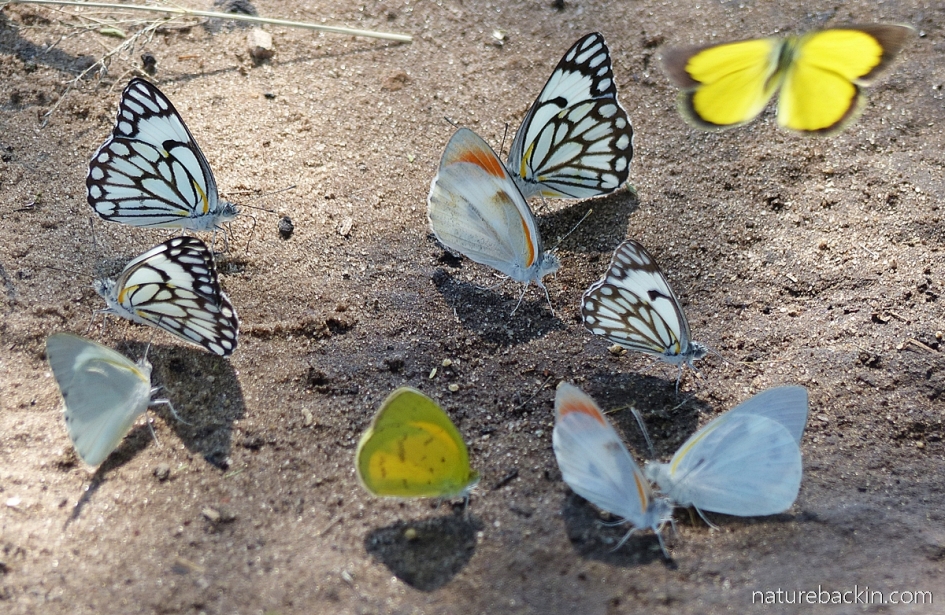
A Broad-bordered Grass Yellow (showing the broad black borders on its upper wings) can be seen flitting fast over a mud muddle where Pioneer Caper Whites/Brown-veined Whites, Orange Tips and African Migrants are taking advantage of the moisture

Less frequently at the mud puddles we saw the very striking Yellow Pansy (Junonia hierta cebrene) butterflies although they are a common species in the region. They occur also more widely across the drier parts of sub-Saharan Africa and on the Arabian Peninsula
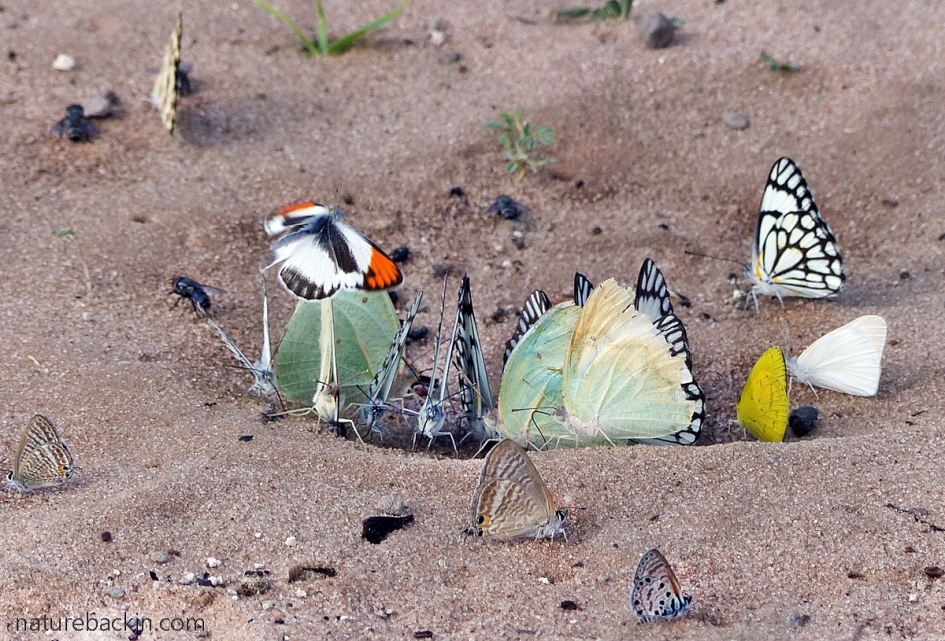
Another delightful assembly of butterflies (and a few flies) at a mud puddle. At this spot we saw Pioneer Caper Whites/Brown-veined Whites, African Migrants, Broad-bordered Grass Yellows, Common Orange Tip butterflies and two species of the ‘Blues’ can be seen in the foreground
Several of the butterfly species that occur in the Kgalagadi region have migratory habits but the best known migrants are the Pioneer Caper Whites/Brown-veined Whites and the African Migrants because of massive migrations of these species that take place every so often, the most recent being the migration of Brown-veined Whites in January 2020. Rather than true migrations (as they don’t return) these mass movements of butterflies are more accurately described as dispersing (or emigrating) butterflies. Thousands and thousands of butterflies leave the Kalahari region and travel consistently in a north-easterly direction stopping in adverse weather conditions and to rest and feed as they go, with the females depositing eggs on larval host plants.
Larsen describes a massive migration of mostly African Migrant butterflies from Botswana in 1991. It was estimated that 1.5 billion individuals took part in this migration event. Interestingly he describes differences in morphology and behaviour of migrating compared to non-migrating individuals. For example, most migrating females were white morphs, looking more like typical males, than the yellow form that is more typical for females (1992b Larsen: 5).
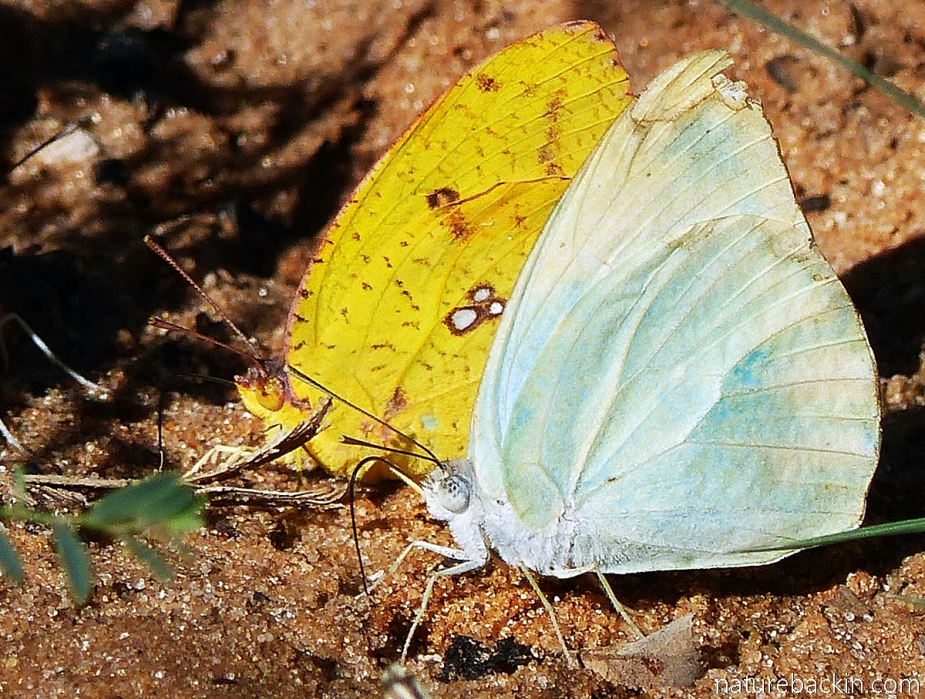
African Migrant (Catopsilia florella) butterflies at a damp patch of sand in Mabuasehube Game Reserve. The yellow is the typical colouration for the female and the white with a greenish hue is the typical coloration of the male
Larsen refers to a previous massive migration in 1966 when African Migrants were predominant, although smaller numbers of Pioneer Caper Whites/Brown-veined Whites and African Monarchs (Danaus chrysippus) were also reported.
In the 1991 migration he mentions “modest numbers” of fellow travellers, including Common Diadem (Hypolimnas misippus), African Monarch (Danaus chrysippus), Pioneer Caper Whites/Brown-veined Whites (Belenois aurota), Yellow Pansy (Junonia hierta), Broad-bordered Grass Yellow (Eurema brigitta) and Spotted Joker (Byblia ilithyia) in varying proportions of the total number.

An African Monarch (Danaus chrysippus) feeding from the purple flowers of the Cat’s Tails (Hermbstaedtia fleckii) that brightens up the grasslands at Mabuasehube in the late summer
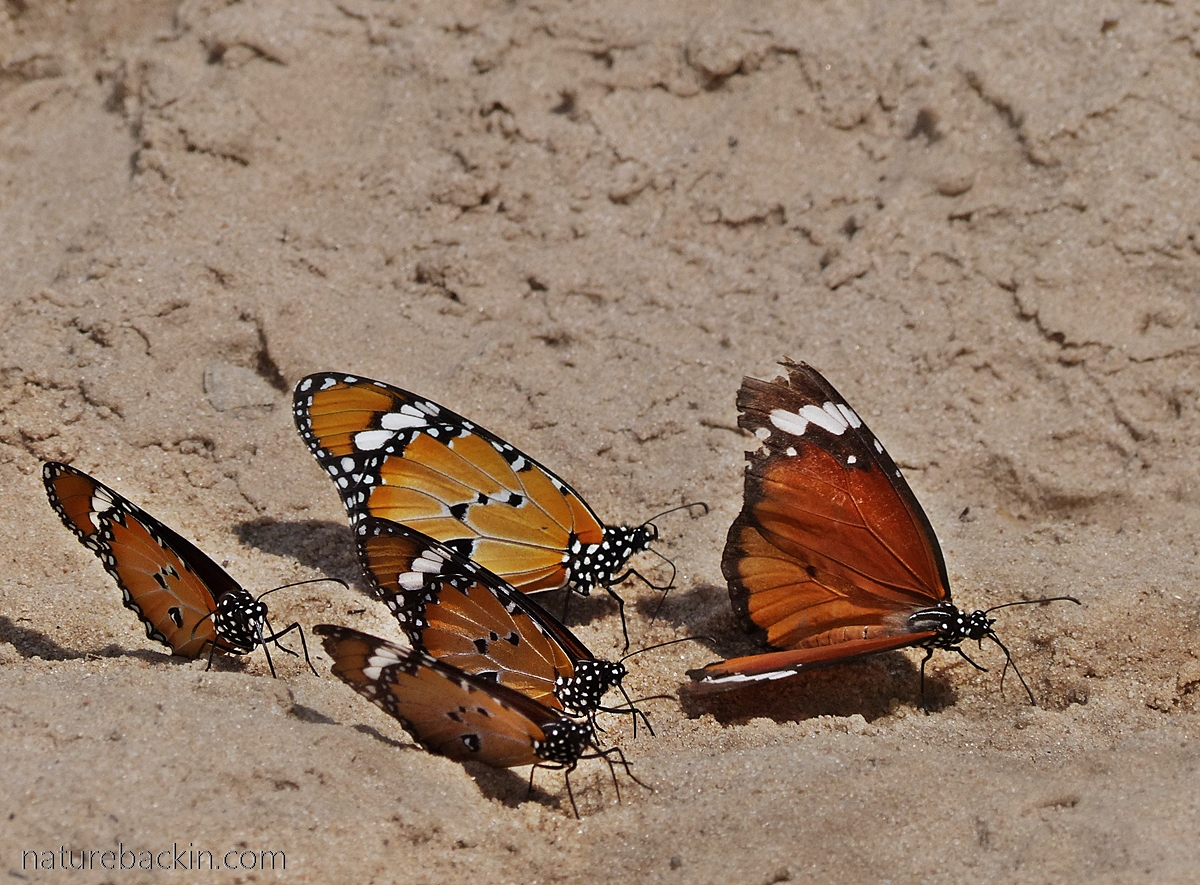
African Monarchs mud-puddling at Mabuasehube. This species (Danaus chrysippus), also known as Plain Tigers, has a wide range that includes most of Africa, much of Asia including India and it also occurs in parts of Australia and parts of southern Europe. It is distinct from the monarch species (Danaus plexippus) that occurs in North America
It is thought that the migrations of butterflies from the Kalahari take place most years but the explosion of vast numbers of butterflies occurs following good rains after a long period of drought. The African Migrants main larval host plant is a species of cassia a wild senna (Senna italica), a yellow-flowered ground creeper, which does exceptionally well after rains to the potential benefit of African Migrant caterpillars.

Commonly known in South Africa as Brown-veined Whites the Belenois aurota species, elsewhere more generally known as the Pioneer Caper White, occurs across most of Africa, the Arabian Peninsula and into Southern Asia and India
The exceptionally large migration of mainly Brown-veined Whites across southern Africa in January 2020 attracted a lot of attention including in the media. It is thought to have been the largest migration since 1966. The Kgalagadi Butterfly Migration originates in the dry Kgalagadi region and in parts of the northern Karoo. However, local butterflies on the migration route will join in the migration as it passes by. The butterflies migrate over several weeks to the wetter north-easterly regions crossing the breadth of southern Africa eventually reaching Mozambique in the east. Millions of butterflies crossing the country is a spectacular sight and their enormous numbers even grace highly urbanised areas including Johannesburg.

The larval host plant for the Pioneer Caper White/Brown-veined White butterflies in the Kgalagadi region is the Shepherd’s Tree (Boscia Albitrunca), a member of the Caper family. This photo was taken in the CKGR, Botswana. As the larvae (caterpillars) eat only indigenous plants in the Caper family, migrating butterflies do not pose a threat to crop plants. Migrating Brown-veined White butterflies lay their eggs only on plants in the Caper family

The Spotted Joker (Byblia ilithyia) has been observed taking a modest part in the migrations of the African Migrant butterflies. In the photo above two small butterflies in the ‘Blues’ family can be seen to the right of the colourful Spotted Joker with its wings spread in the early morning sunlight at the CKGR, Botswana

Although they are small, many blues species are migrants. Although I hesitate to make a pronouncement, I wonder whether this individual photographed at the CKGR is a Pea Blue (Lampides boeticus), which is a migratory species sometimes seen in the region
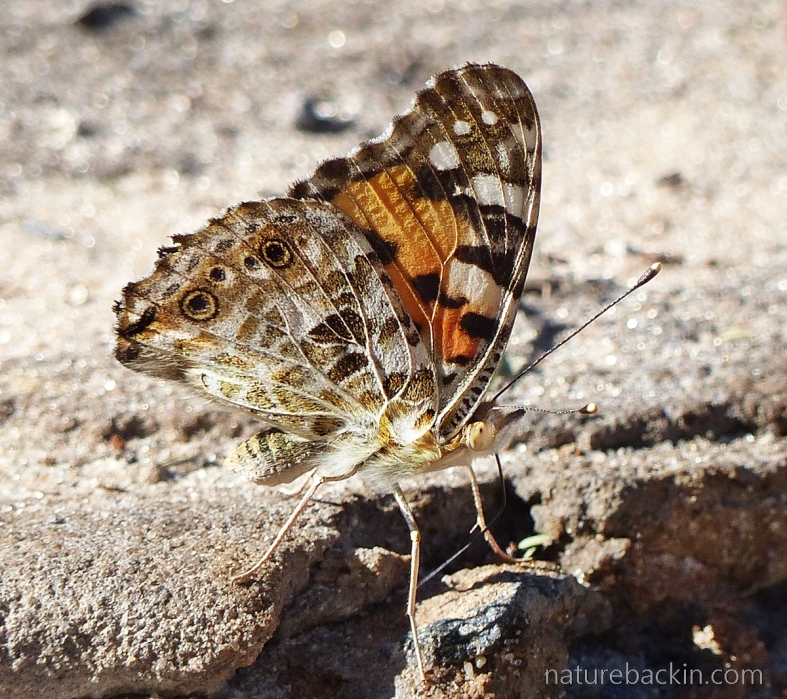
The Painted Lady (Vanessa cardui cardui) is a well-known cosmopolitan species of butterfly with a wide distribution, including in Mabuasehube, Botswana. This one I photographed sucking up moisture and minerals in a damp spot at the edge of a camp fireplace
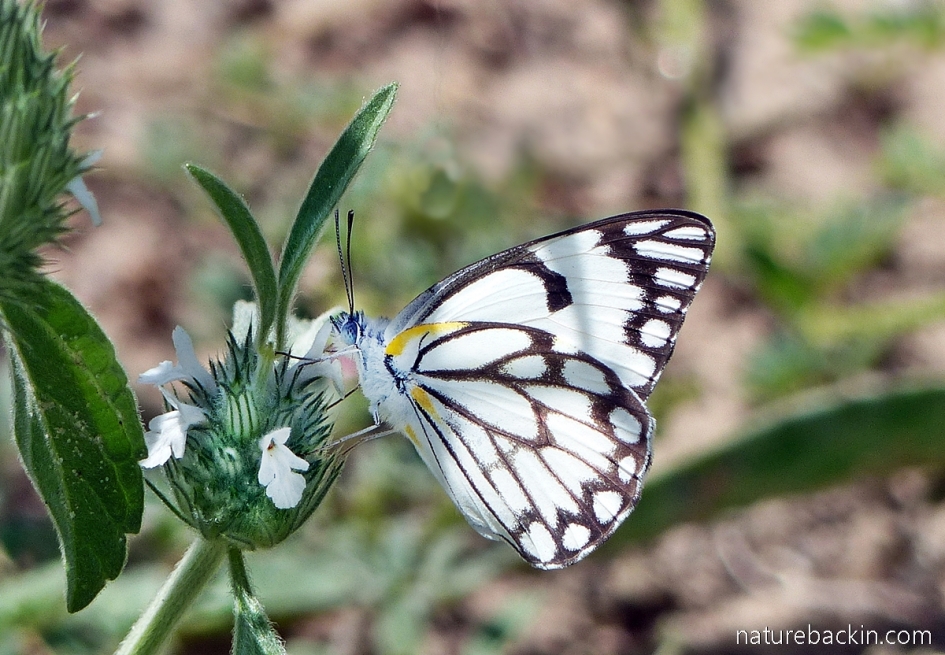
I photographed this Pioneer Caper White/Brown-veined White butterfly feeding from a plant next to our secluded campsite on the edge of the Lesholoago Pan at Mabuasehube. The only other campsite at Lesholoago is on the other side of the pan
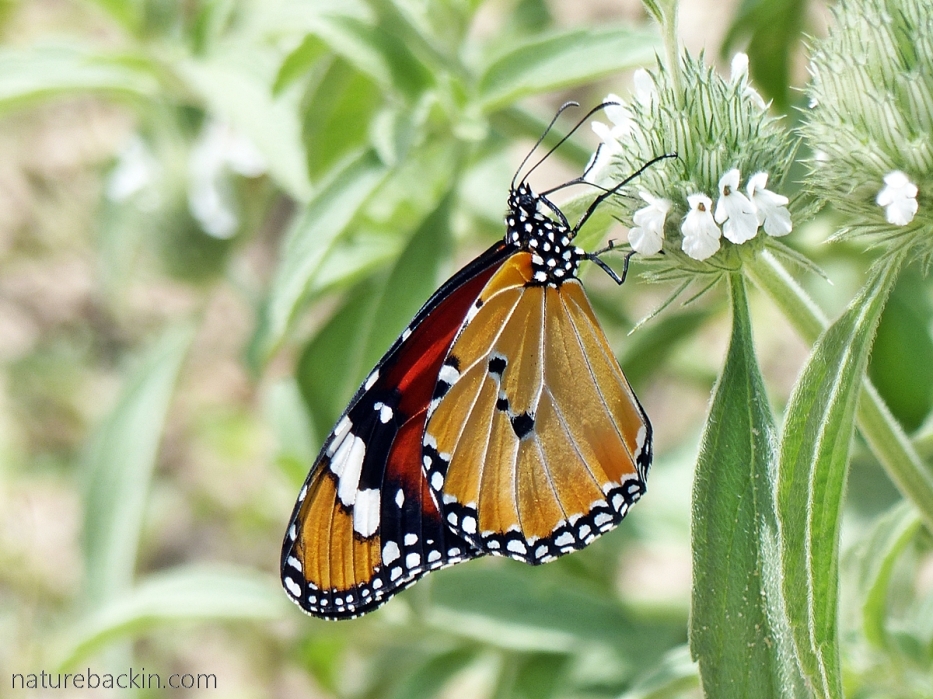
This African Monarch also favours feeding from this species of flowering plant. I have not been able to identify the plant, which is a fairly low-growing herb, and I would be grateful for any assistance in identifying it

Back lit by the setting sun a yellow female African Migrant butterfly takes nectar from a gazania flower at the CKGR
Sources
Larsen, T.B. 1992a. The butterflies of the Gemsbok National Park in Botswana (Lepidoptera Rhopalocera). Botswana Notes and Records 24:181–204 https://journals.co.za/doi/pdf/10.10520/AJA052550590_278 ; Larsen, T. B. 1992b. Migration of Catopsilia florella in Botswana (Lepidoptera:Pieridae).Tropical Lepidoptera, 3:2-11. https://www.academia.edu/1770650/A_Migration_of_Catopsilia_Florella; Terblanche, RF. 2020. Current waves of butterfly migration over southern Africa. 30 January. Statement for LepSoc Africa. https://cdn.24.co.za/files/Cms/General/d/9912/967aed4d7e114b4ca28f65cf7c06573c.pdf; Woodhall, Steve. 2013. Pocket Guide Butterflies of South Africa. Cape Town: Struik Nature.
Posted by Carol









April 11, 2021 at 9:37 am
This was a real feast, Carol with wonderful photographs and information.
LikeLiked by 1 person
April 12, 2021 at 6:40 pm
Thanks very much Christine. It is fantastic seeing so many butterflies clustered together like that.
LikeLike
April 3, 2021 at 1:17 am
This post brightened my day, too. I truly admire your ability to catch all these various butterflies. It seems as though ours flit around so much that I hardly have time to find them through the lens, much less focus.
I so much enjoy your posts as they seem to soothe my soul in a time of need. It’s good to hear you’re health is holding up and that (hopefully) there will be no new spikes. I will be considered ‘fully’ vaccinated a week from now. Eric, however, has nearly six more weeks to go to get to that same level. Just for an extra bit of excitement, Eric seems to have stirred things up by reporting the town police chief as violating stream-side environmental protections. Oh my! 😕
LikeLiked by 1 person
April 5, 2021 at 2:48 pm
Yes most butterflies here also flit by far to rapidly to photograph, Those congregating butterflies taking their time to suck in moisture where much easier to photograph.
I am glad to hear you have been vaccinated though sorry to hear that Eric will need to wait for so long. We are hoping to be vaccinated in June or July, but will have to wait to see how things go.
Brave of Eric to report the police chief who of all people should know better. I hope that protocols are observed and something comes of it. Good luck with that.
LikeLike
March 15, 2021 at 10:20 am
You have no idea as to the extent this post of yours has brightened my Monday, Carol. Such skillfully crafted photographs of incredibly beautiful subjects. Thank you!
LikeLiked by 1 person
March 16, 2021 at 6:10 pm
Thanks Dries – I am happy to know that the desert butterflies brightened up your Monday.
One thing about autumn, we have lots of butterflies visiting in our neighbourhood currently 🦋
LikeLiked by 1 person
March 17, 2021 at 1:24 am
I’m looking forward to some of them migrating over here soon! 😀
LikeLiked by 1 person
March 14, 2021 at 9:29 am
I have picked a perfect moment to return to your glorious blog, Carol! I remember the posts on resilience, fragility and hope and here we are, enjoying another marvellous butterfly offering. Stunning photography, thank you. The thought of those mass-emigrations is breath-taking. Have you ever witnessed one? I hope all is well 😊
LikeLiked by 1 person
March 14, 2021 at 1:35 pm
Hallo Sandra and how lovely to hear from you. We did witness a migration once when we were driving home across the country after a trip to the arid regions of the west. The floating and bobbing flocks of butterflies appeared to be endless – it was beautiful and astonishing.
We are fine here thanks. Thankfully infection rates are way down although a ‘third wave’ is predicted. The vaccination programme is rolling out slowly, starting with health workers, but it is expected to accelerate over the next few months.
I hope you are keeping well and safe too.
LikeLiked by 1 person
March 14, 2021 at 5:33 pm
I can’t imagine how it must have been to witness that. What an experience.
Glad to hear you’re well and that infection rates are down. I hope that predicted third wave is tempered by the vaccination programme when it gets going more widely. I’ve had my jab this afternoon as it happens, Carol 😊 The UK has done well with the vaccination programme. Just a little too late to prevent first my mother and then my father from catching the virus. Thankfully we have got them both through it although not without consequences. It’s Mother’s Day here in the UK. Very poignant for many this year. We are just thankful that Mum is still here, many mothers are not.
Take good care 😊
LikeLiked by 1 person
March 16, 2021 at 6:06 pm
Hi Sandra
That is good that you have had your jab, but I am so sorry that your mum and dad both got the virus. It must have been such a frightening time. I hope that they continue to recover and gain in strength each day.
It is so sad to think about Mother’s Day in the context of the pandemic and the very many people who lost their mothers.
Now we can only hope that vaccine programmes can rolled out effectively across the globe and in the meantime everyone continues to observe the protocols.
You take good care too – thank you.
LikeLiked by 1 person
March 14, 2021 at 2:47 am
Beautiful, beautiful post! Most of which I had never seen before. 🌈 Loved that the African Monarch looks very much like the Monarch we have here in the states. Our Monarch only eats milkweed.Could the mystery flower be a type of milkweed? Loved your take on strength and vulnerability. Last year, I had a swallowtail in the yard that I watched for many days. I knew it was the same single butterfly because one of its wings was incomplete. Yet it still managed somehow. And it just gets you thinking, doesn’t it? Thanks for posting!
LikeLiked by 1 person
March 14, 2021 at 1:02 pm
Thanks for your thoughtful response Julie. We can learn from nature in many ways! There is something touching about watching a damaged butterfly continuing to survive.
Re the ID of the plant, Eliza gave me a steer to the Lamiaceae (mint) family and from there I found out it was one of only 8 species in the Acrotome genus all of which occur only in southern Africa.
I gather that even if the caterpillars are limited to only one or a few species/genera of food plants, the adult butterflies can take nectar from a broader variety of plants with nectar-rich flowers and not only from the plants that host their caterpillars.
LikeLiked by 1 person
March 13, 2021 at 9:44 pm
I was particularly struck by the groups of moisture-seeking butterflies you show us. I don’t think I’ve ever seen this phenomenon here. And it’s only recently that I’ve understood that some butterflies can migrate, so that was interesting too. Another fascinating post.
LikeLiked by 1 person
March 14, 2021 at 12:52 pm
Thanks Margaret. Mud puddling certainly is an interesting phenomenon. I gather that it is done more by males than female, but at Mabuasehube female African Migrant butterflies for instance have been observed participating more than in other regions. All very interesting and complex! And beautiful too!
LikeLike
March 13, 2021 at 4:50 pm
This post was a complete joy, Carol, thank you so much. I enjoyed your narrative about the difficulty of this past year, espec. this sentence in relation to it: “Desert butterflies exemplify a complex relationship between strength and vulnerability and the ability to survive in challenging circumstances.” Then the butterfly extravaganza was truly breath-taking. Your photos and Kalahari descriptions were stellar. Thanks so much for sharing these beautiful creatures with us.
LikeLiked by 2 people
March 13, 2021 at 7:18 pm
Thanks so much for your generous comment, Jet. There is something especially inspirational about desert butterflies. It is so apt to describe those assemblies of butterflies as an extravaganza! 🦋
LikeLiked by 1 person
March 13, 2021 at 4:11 am
Fabulous collection of photos, Carol. Such a variety of colors and markings in those butterflies. It must be quite the sight to see them in huge numbers during a migration.
LikeLiked by 1 person
March 13, 2021 at 11:38 am
Thanks Graham. The variety is amazing. We once saw quite a large butterfly migration when we were travelling back from the arid west to where we are on the eastern side of SA. Mile after mile there were hundreds and hundreds of white butterflies bobbing and flitting along seemingly without end and all maintaining a consistent direction. An incredible sight.
LikeLiked by 1 person
March 13, 2021 at 6:57 pm
Lucky you, seeing that.
LikeLiked by 1 person
March 12, 2021 at 5:00 pm
Love these winged beauties, Carol!
LikeLiked by 1 person
March 12, 2021 at 7:38 pm
Thanks Sandy – the harsh desert sands context somehow enhances their beauty.
LikeLiked by 1 person
March 12, 2021 at 8:20 pm
Very true!
LikeLiked by 1 person
March 12, 2021 at 3:24 pm
It’s no wonder that butterflies are a symbol of hope! When I see all that beauty that exists even in hostile environments I am in awe.
Brilliant pictures with a lot of helpful informations!
LikeLiked by 1 person
March 12, 2021 at 7:37 pm
Thanks very much Simone. And indeed it is awesome and inspirational that butterflies, so seemingly fragile, manage to survive in such hostile environments.
LikeLiked by 1 person
March 12, 2021 at 2:02 pm
SImply marvellous photographs and commentary! Each of these photographs is worthy of framing.
LikeLiked by 1 person
March 12, 2021 at 7:35 pm
Thanks very much Anne. It is marvelous to be able to witness so many butterflies clustered together.
LikeLike
March 12, 2021 at 1:34 pm
I had a few thoughts on your mystery plant… it seems to be of the Lamiaceae (mint) family (square stems and flowering habit) similar to Salvia, Leonotis or Monarda. It may not even be native, so might be hard to find a definitive reference.
LikeLiked by 1 person
March 12, 2021 at 7:34 pm
Thanks so much Eliza. I had already investigated Leonotis and Salvia species with no luck. Thanks for the square stem info and I decided to look at Lamiaceae in Botswana – found an online guide and I was lucky to very quickly identify it as belonging to the genus Acrotome – native to southern Africa with only 8 species. I think the one at Mabuasehube is Acrotome angustifolia (with the other possibility being Acrotome inflata). I can’t find much about it but it is nice to know that it is a native species. Mabuasehube is quite remote with no rivers or many other vectors for bringing exotic plants into its rather harsh environs. Thanks again 🙂
LikeLiked by 1 person
March 12, 2021 at 8:01 pm
Glad to assist!
LikeLiked by 1 person
March 12, 2021 at 1:32 pm
I am (almost) lost for words. Spectacular photographs, meticulous information. Thank you Carol for this uplifting post.
LikeLiked by 1 person
March 12, 2021 at 7:00 pm
Thank you Mariss and I am glad to hear it was uplifting 🙂
LikeLiked by 1 person
March 12, 2021 at 1:03 pm
Delightful post about your puddling butterflies, Carol. It must be amazing to see millions of them emigrating. I was in Los Angeles, CA two years ago and saw Painted Ladies migrating north… it was pretty crazy to see so many flying over the thru-ways!
LikeLiked by 1 person
March 12, 2021 at 6:59 pm
Thanks Eliza. Seeing that migration of Painted Ladies must have been quite something.
LikeLike
March 12, 2021 at 8:03 pm
I’d never see so many at once in my life. It was like a river parade of butterflies!
LikeLiked by 1 person
March 12, 2021 at 12:27 pm
We usually have a fly-past of Brown-veined Whites in October. I did notice slightly more activity in January, but we obviously weren’t on a direct route. I love butterflies, their ephemeral beauty and grace mesmerise me, thank you Carol! xxx
LikeLiked by 1 person
March 12, 2021 at 6:58 pm
Interesting that you see the edge of the fly past. We have seen a few Brown-veined Whites here but they are perhaps resident rather than migrating.
Yes there is something very special about butterflies – there are many about currently, which is one of the nice things about the months of autumn.
LikeLiked by 1 person
March 12, 2021 at 11:57 am
Lovely post.
It’s truly amazing that these insects only do a ”one way” trip.
It was a bit of a strain at first to work out how they replenish the stock if they all ‘vrek’
I was told by someone in the know that the 99/20 dispersal was the largest since 1966.
They fly through our property every year and a few years back I planted a hedge of lavender as a ‘pit-stop’ for them!
I took a photo of what I thought was a Common Orange Tip and posted the photo on an SA Butterfly site on Facebook.
My amateur ID was soon corrected and I was informed that the butterfly I had photographed was, in fact, a Teracolus agoye bowkeri, which hadn’t been photographed since the ’66 dispersal!
What do I know?
LikeLiked by 1 person
March 12, 2021 at 6:56 pm
Thanks Ark. Yes the one-way trip is interesting, but they are depositing eggs along the way … Also I gather, not all butterflies migrate.
It is interesting that they like your lavender hedge 🙂
I have just looked at a pic of the Teracolus agoye bowkeri – hard to distinguish it from the Common Orange Tip but you evidently had a special sighting!
LikeLiked by 1 person
March 12, 2021 at 7:03 pm
*Shrug* I’m clueless, but the clever clogs on Facebook seemed to know his stuff.
I did a post last year which included the comment from the FB chap.
https://attaleuntold.wordpress.com/2020/01/31/it-fluttered-by-again/
LikeLiked by 1 person
March 12, 2021 at 7:46 pm
I just peeped at some of your butterfly posts – gorgeous shots and you clearly are far from clueless 🙂🦋
LikeLiked by 1 person
March 12, 2021 at 7:47 pm
Google and I are ”besties”. 😉
LikeLiked by 1 person
March 12, 2021 at 7:53 pm
🙂 – a great team!
Btw, I have been trying out Duckduckgo as an alternative – so far so good …
LikeLiked by 1 person
March 12, 2021 at 7:57 pm
I downloaded it some time ago but after a while I couldn’t see the point so went back to Google.
What was your reason for the switch, if I might ask, Carol?
LikeLiked by 1 person
March 13, 2021 at 11:45 am
My reasons are the same as Graham explains so well in his comment – DuckDuckGo does not track or store one’s search history and does not share the info it gathers with advertisers. Perhaps such resistance is meaningless but one does not get personally targeted ads, which I prefer (ads are based on the topic not on one’s search history). Also search results are the same for everyone using the same search terms – results are not tailored according to the profile built up around one’s search history and so one lives less in tailored bubble.
LikeLiked by 1 person
March 13, 2021 at 4:14 am
Good for you. I’ve been using DuckDuckGo for years now. It’s been just fine and they don’t track your every move online. Google, AKA the evil empire, tracks everything, ‘for your benefit.’ That’s such rubbish. It’s purely to gather information and enable them to sell more targeted advertising. I try and avoid Google (and others like them) as much as possible. Sorry, rant over.
LikeLiked by 1 person
March 13, 2021 at 11:48 am
I completely agree with your very coherent rant! I also avoid what I can and don’t use FB or WhatsApp, and I try to keep on top of the privacy settings – a never-ending task though!
LikeLiked by 1 person
March 13, 2021 at 7:00 pm
Never-ending and almost impossible, but I feel better for making the effort. I’m amazed at how easily many people surrender so much of their privacy.
LikeLiked by 1 person
March 13, 2021 at 7:30 pm
I agree. I wonder what George Orwell would think about how we willingly invite the ‘telescreens’ into our lives so uncritically!
LikeLiked by 1 person
March 14, 2021 at 4:34 am
Probably thinking, ‘I warned you.’
LikeLiked by 1 person